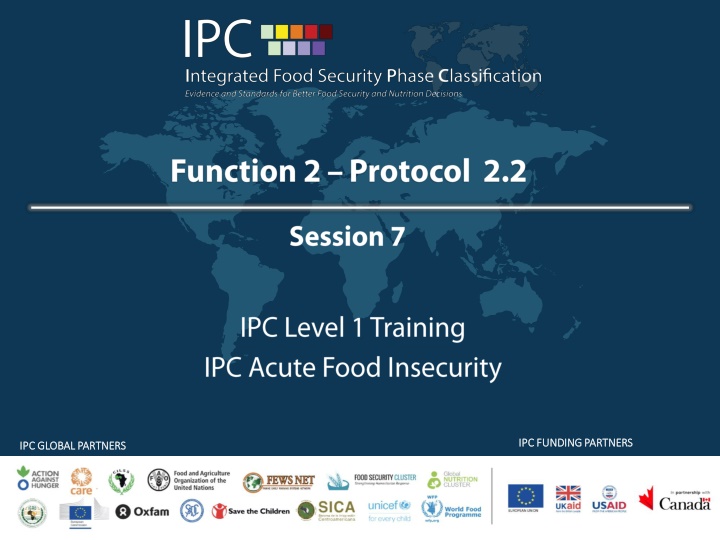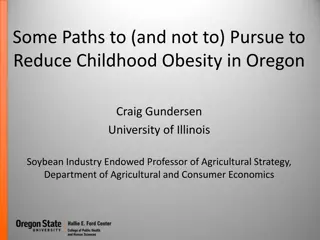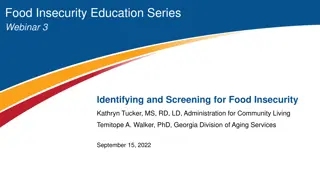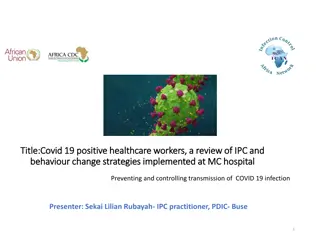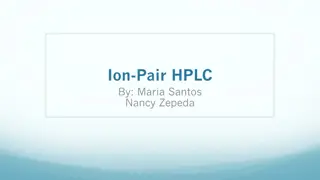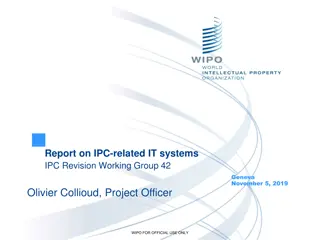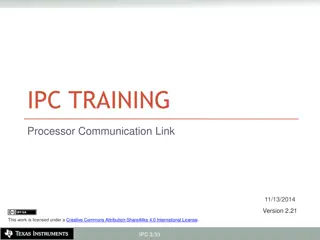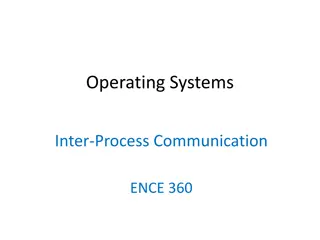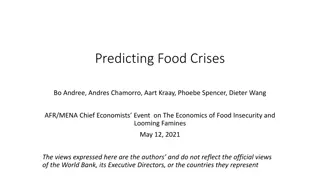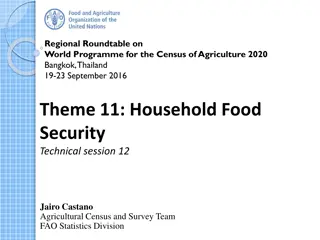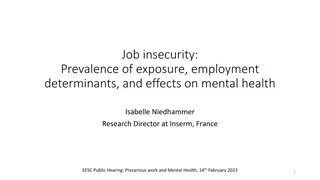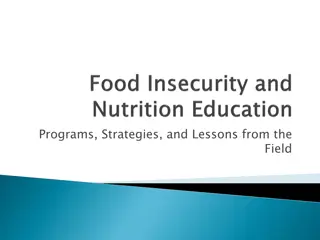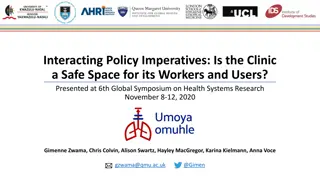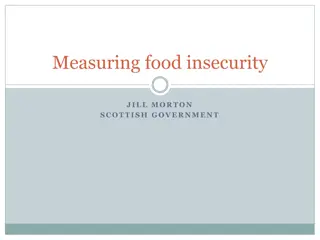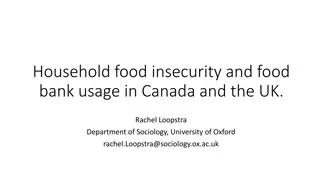IPC Funding Partners & Protocol 2.2 - Understanding Food Insecurity
The content delves into IPC funding partners, Protocol 2.2, and how the IPC Reference Table guides evidence convergence in food insecurity assessment. Exploring the analytical framework's phases, severity descriptions, and response objectives elucidates actions for urgent situations. With a focus on comparing evidence against international standards, the content highlights the importance of evaluating direct and indirect evidence to assess food insecurity accurately.
Download Presentation

Please find below an Image/Link to download the presentation.
The content on the website is provided AS IS for your information and personal use only. It may not be sold, licensed, or shared on other websites without obtaining consent from the author.If you encounter any issues during the download, it is possible that the publisher has removed the file from their server.
You are allowed to download the files provided on this website for personal or commercial use, subject to the condition that they are used lawfully. All files are the property of their respective owners.
The content on the website is provided AS IS for your information and personal use only. It may not be sold, licensed, or shared on other websites without obtaining consent from the author.
E N D
Presentation Transcript
IPC FUNDING PARTNERS IPC FUNDING PARTNERS IPC GLOBAL PARTNERS IPC GLOBAL PARTNERS
Protocol 2.2: Compare Evidence against the Reference Table To guide converge of evidence by using generally accepted international standards and thresholds. What is the objective of Protocol 2.2? How does Protocol 2.2 work? It is organized according to the Analytical Framework It provides a description of the typical characteristics for each Phase Each Phase is linked to priority response objectives. It identifies generally globally comparable cut-offs for key food insecurity outcome indicators (aka direct evidence). It acknowledges that indicator cut-offs will at times not align due to context issues and indicator characteristics and reliability As such all evidence needs to be critically evaluated, contextualized and only then related to different severities of food insecurity.
How does the IPC Reference Table work? Organized as per the IPC Analytical Framework
How does the IPC Reference Table work? 5 Phases with general descriptions of expected severity of conditions Task 1: In groups of 3-5 people review the description for one Phase and summarize it into 15 words (at most!) Exercise 7.1
How does the IPC Reference Table work? Each Phase is linked to priority response objectives for Action. Phase 3 or worse require Urgent Action! Task 2: In groups of 3-5 people identify 2-3 potential actions might be applicable to meet the different priority response objectives Exercise 7.1 (cont d) Be ready to share in plenary with the group!
How does the IPC Reference Table work? General Severity of Each Element is provided
How does the IPC Reference Table work? Includes selected indicators and cut-offs for different Phases (a.k.a. direct evidence) Further evidence (a.k.a. indirect evidence)can, and should, be used against Phase and Element Descriptions Cut-offs are guides only as indicators do not necessarily align.
Food Consumption Outcome The Indicators in the IPC Reference Table (1) Food Consumption (Quantity & Quality) Dietary Energy Intake (kcal) - reference Household Dietary Diversity Score (HDDS) Food Consumption Score (FCS) Household Hunger Score (HHS) Reduced Coping Strategy Index (rCSI) HH Economy Approach (HEA) Food Insecurity Experience Scale (FIES) 8
Livelihood Change The Indicators in the IPC Reference Table (2) Livelihood Change (Assets & Livelihoods) General description Livelihood Coping Strategy (LCS) Livelihood Change (Assets & Strategies) Description of Livelihood Strategies Livelihood Coping 9
The Indicators in the IPC Reference Table (3) Contributing Factors No universal thresholds because they depend on context general description only Divided into: Food Availability, Access, Utilization & Stability Hazards & Vulnerability Table of Potential evidence to support IPC analysis included in IPC Resources 10
The Indicators in the IPC Reference Table (4) Nutritional Status WHZ (Weight for height) < -2 SD MUAC (mid-upper arm circumference) <125 mm BMI (Body Mass Index) <18.5 Mortality CDR (Crude Death Rate) U5DR (Under 5 Death Rate) 11
Food Consumption & Livelihood Change Outcome Provide a three minute explanation on a selected indicator Exercise 7.2 In groups of 3-5 people: - Review the slide on your specific indicator - Provide a three minute explanation on the indicators focusing on: - Indicator meaning and construction - How indicator is used for IPC - What are the key considerations analysts should keep in mind about this indicator when using it Be ready to answer a lot of questions!
Food Consumption & Livelihood Change Outcome Exercise 7.2 DIVE IN!!
Dietary Energy Intake Construct: Dietary Energy Intake A reference indicator for food consumption section of the Reference Table Focuses on average kcal consumption of groups of individuals of average height and weight (BMI of 21- 22) Cut-off of Phase 1 (2,350 kcal) based on moderate physical activity level (PAL 1.75) and for Phase 2 (2,100 kcal) on sedentary lifestyle (PAL 1.55) Acute Food Insecurity Reference Table Phase Dietary Energy Intake Adequate (avg. 2,350 kcal pp/day) and stable 1 Minimally adequate (avg. 2,100 kcal pp/day) 2 Limitations: No specific cut-offs exist for Phases 3-5 and difficult to develop Data rarely available Food gap (below avg. 2,100 kcal pp/day) 3 4 Large food gap; much below 2,100 kcal pp/day 5 Extreme food gap 14
Food Consumption Outcome Household Dietary Diversity Score (HDDS) Construct: A proxy for household access to different food groups Score is a number of food groups HH has eaten in the previous 24 h out of 12 food groups Household Dietary Diversity Score (HDDS) has been validated as a proxy for household energy availability. Acute Food Insecurity Reference Table Limitations: HDDS doesn t include quantities consumed With a recall period of 24 h, it does not capture seasonality or other changes unless it is collected periodically According to some studies HDDS appears to be a measure of both quantity and quality of food Results of HDDS may also be confounded in contexts where food aid is provided HDDS collected with 8-9 food groups and 7-day recall period divided by 7 cannot be used as direct evidence in IPC analysis Phase HDDS cut-off 1 & 2 5-12 3 3-4 4 & 5 0-2
Food Consumption Outcome Food Consumption Score (FCS) Construct: FCS is a composite score based on dietary diversity, food frequency (# days in 7 days) and the relative nutritional importance of different food groups, in particular considering protein content Limitations: Acute Food Insecurity Reference Table FCS does not consider intra-HH food distribution FCS is a snapshot of one week of food consumption FCS does not provide information on actual quantity of food consumed In areas with low food diversity people may still get adequate or moderately inadequate energy intake also with low FCS: FCS may over-estimate households in IPC Phase 4 Phase 1-2 FCS cut-off Acceptable 3 Borderline 4 Poor 16
Food Consumption Outcome Household Hunger Scale (HHS) Construct: The Household Hunger Scale (HHS) assesses whether households have experienced problems in food access in the preceding 30 days by measuring the severity of food insecurity for that period, as reported by the households themselves A measure of access to food (quantity) Acute Food Insecurity Reference Table Phase HHS cut-off 1 2 3 4 5 0 1 2-3 4 5-6 Limitations: Among the limitations of the HHS is its tendency to measure better severe food insecurity, rather than normal situations 17
Food Consumption Outcome Reduced Coping Strategies Index (rCSI) Construct: rCSI is an indicator of household food security based on five questions about how households manage to cope with a shortfall in food for consumption Limitations: It has been noted that rCSI is of limited value in severe crisis situations, where households ability to cope by employing strategies included in rCSI has already been eroded It is advised to emphasize the use of rCSI in analysis of household experiences of food insecurity in lower Phases (Phases 1-3), and emphasize the use of Household Hunger Score indicator (HHS) for the same purpose in higher Phases (Phases 3-5) Acute Food Insecurity Reference Table rCSI cut-off 0-3 4-18 19-42 (Currently under testing 43) Adopted cut-offs tentative, feedback appreciated Phase 1 2 3 4-5 18
Food Consumption Outcome Household Economy Analysis (HEA) Construct: The Household Economy Approach (HEA) is a livelihoods-based framework founded on the analysis of: How people in different social and economic circumstances get the food and cash they need Their assets, the opportunities available to them, and the constraints they face Options open to them at times of crisis. The survival threshold represents the most basic of needs, including minimum food energy requirements (kcal) and expenditure related to food preparation and water for human consumption. The livelihood protection threshold represents the survival threshold and additional expenditures needed to maintain and to invest in livelihoods, e.g. through education or purchase of assets. 19
Food Consumption Outcome Household Economy Analysis (HEA) cont. Limitations: For IPC Acute Analysis, reliability of HEA analysis results is typically tied to good quality information included in resources used to run HEA analysis, and to capacity of HEA analysts. IPC TWGs are encouraged to carefully check the assumptions and data included in HEA analysis, and what parameters have been used e.g. in relation to humanitarian assistance. Acute Food Insecurity Reference Table Phase HEA cut-off 1 No livelihood protection deficit 2 Small or moderate livelihood protection deficit <80% 3 Livelihood protection deficit 80% or survival deficit <20% 4 Survival deficit 20% but <50% 5 Survival deficit 50% 20
Food Consumption Outcome Food Insecurity Experience Scale - FIES Construct: It consists of eight questions capturing a range of food insecurity severity, with yes/no responses. For use in IPC analysis the recall period has to be 30 days. Limitations: The FIES analytical methodology involves a sophisticated probabilistic approach to classify households according to their food security status. It may be challenging for non-specialists to conduct the analysis and produce the estimates Acute Food Insecurity Reference Table Phase FIES cut-off (FIES 30 days recall) 1 < - 0.58 2 Between -0.58 and 0.36 3 > 0.36 (NDC to differentiate between Phases 3, 4 and 5) 4 > 0.36 (NDC to differentiate between Phases 3, 4 and 5) 5 > 0.36 (NDC to differentiate between Phases 3, 4 and 5) 21
Livelihood Change Outcome Livelihood Coping Strategies (LCS) Construct: Livelihood coping strategies are divided into three categories: stress, crisis, and emergency strategies. The division is based on the severity and reversibility of the strategy. The most severe strategy used by the household places the household in one of the three categories. Limitations: Coping is context-specific, and as a result strategies need to be appropriate to country context and need to be allocated to appropriate severity categories by the TWG Acute Food Insecurity Reference Table Phase 1 Phase 2 Phase 3 Phase 4 Phase 5 No stress, crisis or emergency coping observed Near exhaustion of coping capacity Livelihood Coping Strategies cut-off Stress strategies Crisis strategies Emergency strategies 22
Nutritional Status Outcome Weight for height Construct: Percentage of children from 6 to 59 months who have Weight for height (WHZ) of <-2 SD or oedema Limitations: Wasting can be a late outcome indicator of a crisis, and response mechanisms based on wasting can be too late for meaningful action In populations where levels of acute malnutrition are high outside times of acute crisis, levels during periods of crisis can be difficult to interpret Wasting is impacted by several factors such as disease, food consumption and care practices. As a result it is often challenging to understand what part of acute malnutrition is due to food related factors, and what part is due to other factors. Phase 1 Phase 2 Phase 3 Phase 4 Phase 5 < 5% 30 Acute Malnutrition Cut-off 5 9.9% 10 14.9% 15 29.9% 23
Nutritional Status Outcome Nutritional Status: MUAC Construct: MUAC is the circumference of the upper arm, measured at the mid-point between the tip of the shoulder and the tip of the elbow. MUAC < 125 mm = moderate acute malnutrition, MUAC < 115 mm = severe acute malnutrition in children of 6 to 59 months. Acute Food Insecurity Reference Table Phase 2 Phase 3 Phase 1 Phase 4 Phase 5 0 4.9% 5 9.9% 10 14.9% 15% 24
Nutritional Status Outcome Nutritional Status: MUAC (cont.) Limitations: No globally endorsed prevalence thresholds for MUAC exist (as opposed to WHZ) Data on MUAC is often of poor quality need well trained enumerators MUAC tends to identify mainly younger children, especially those <2 years old as malnourished and therefore may not be equally applicable for older age groups As cut-offs are not fixed to a single Phase, determination of indicative Phase requires understanding of trend data and relationship of WHZ and MUAC in the country. Only used if WHZ data not available 25
Nutritional Status Outcome Nutritional Status: BMI Construct: BMI is an index of weight-for-height (kg/m2) that is commonly used to classify underweight, overweight and obesity in adults, also called a Quetelet index. The BMI cut-offs are applicable to the adult population, but typically data is collected on non-pregnant women of reproductive age (15 49 years). Limitations: Data rarely available BMI can indicate an acute or a chronic condition BMI Phase 2 Phase 1 Phase 3 Phase 4 Phase 5 < 5% 40 BMI Cut-off 5 9.9% 10 19.9% 20 39.9% 26
Mortality Outcome Crude Death Rate Construct: Crude Death Rate (CDR) is the number of deaths per 10,000 people per day. CDR is frequently used to gauge the severity of a public health emergency, and as a result data on CDR is more often available in emergency situations. Limitations: Despite its direct relationship to extreme food insecurity, it may be difficult to measure CDR in real time during an emergency e.g., due to shifting base populations related to dynamic in-and-out migration High potential for as yet unknown status Difficulties in collecting good quality data on mortality. Furthermore, real-time data are rarely available also because of lack of surveillance systems. CDR Phase 1 Phase 2 Phase 3 Phase 4 Phase 5 < 0.5/10,000/day 2/10,000/day CDR cut-off < 0.5/10,000/day 0.5-0.99/10,000/day 1-1.99/10,000/day 27
Mortality Outcome U5DR Construct: Under 5 Death Rate (U5DR) is the number of deaths of children under 5 per 10,000 children under 5 per day. As with CDR, the Under 5 Death Rate is also more often available in emergency situations. Limitations: Despite its direct relationship to extreme food insecurity, it may be difficult to measure U5DR in real time during an emergency e.g. due to shifting base populations related to dynamic in-and-out migration High potential for as yet unknown status Difficulties in collecting good quality data on mortality. Furthermore, real-time data are rarely available also because of lack of surveillance systems. U5DR Phase 1 Phase 2 Phase 3 1-2/10,000/day Phase 4 Phase 5 < 1/10,000/day 4/10,000/day < 1/10,000/day U5DR cut-off 2-3.99/10,000/day 28
